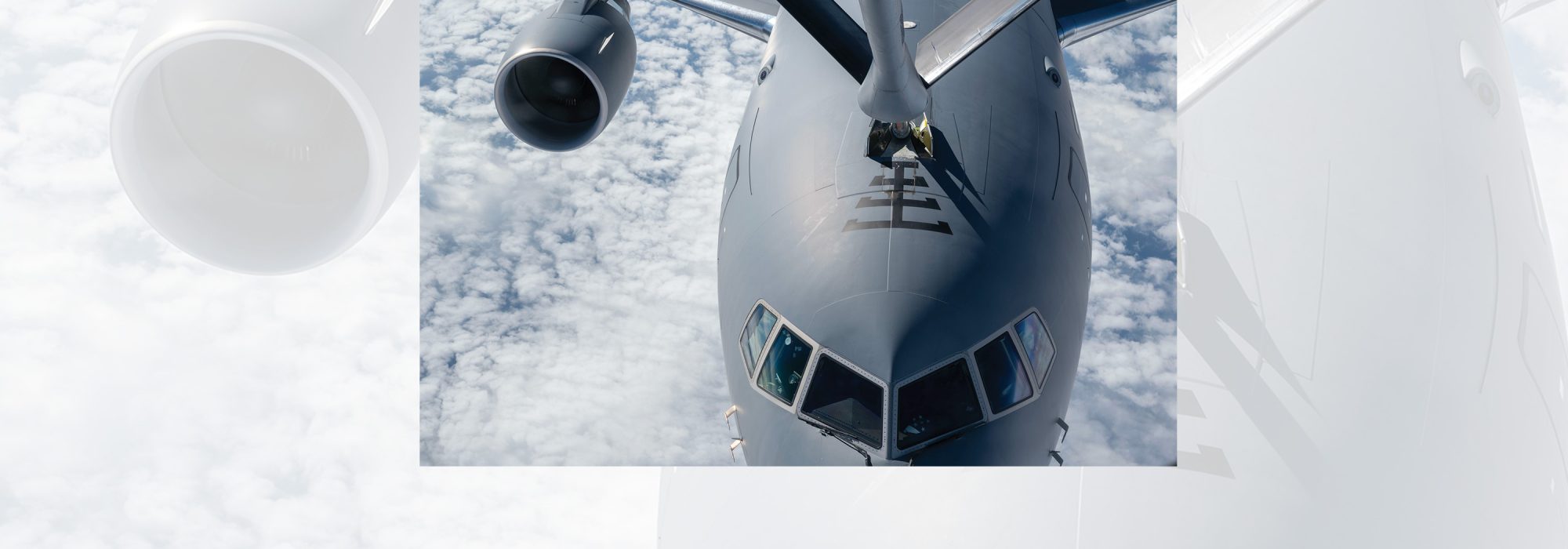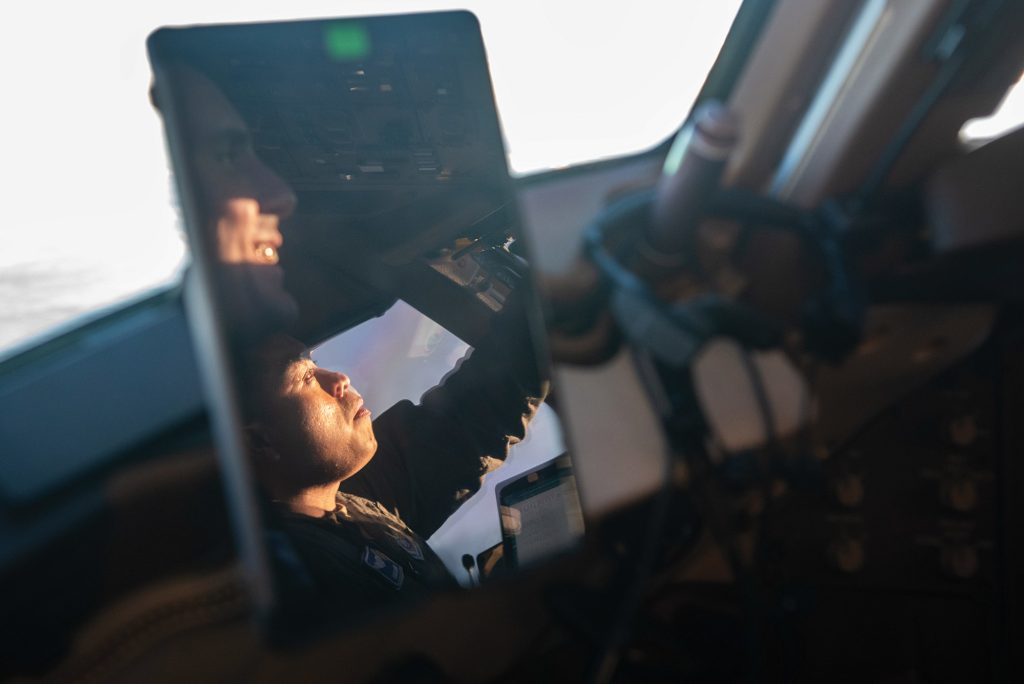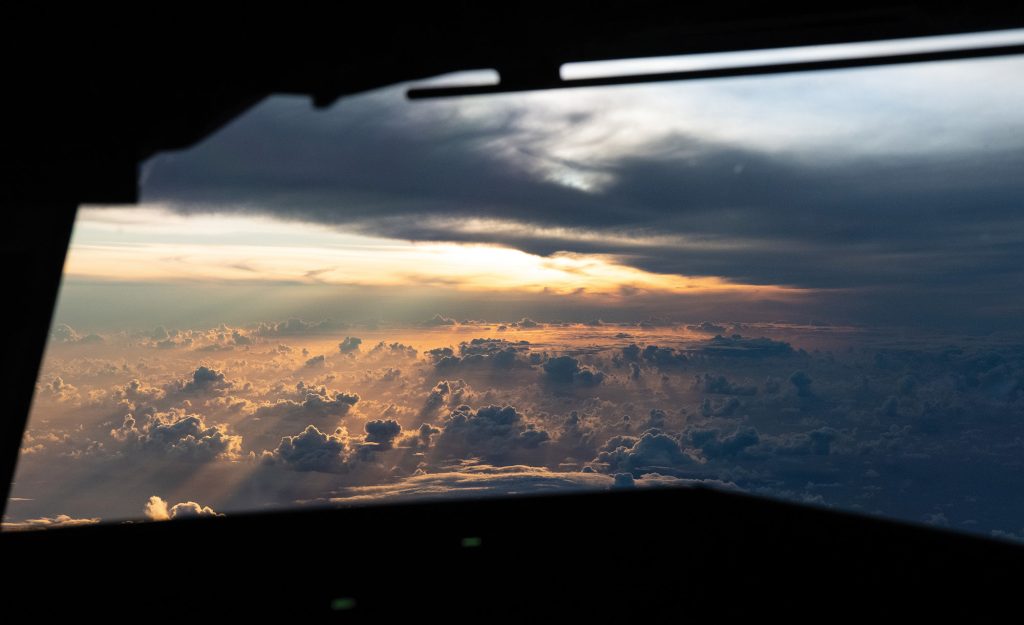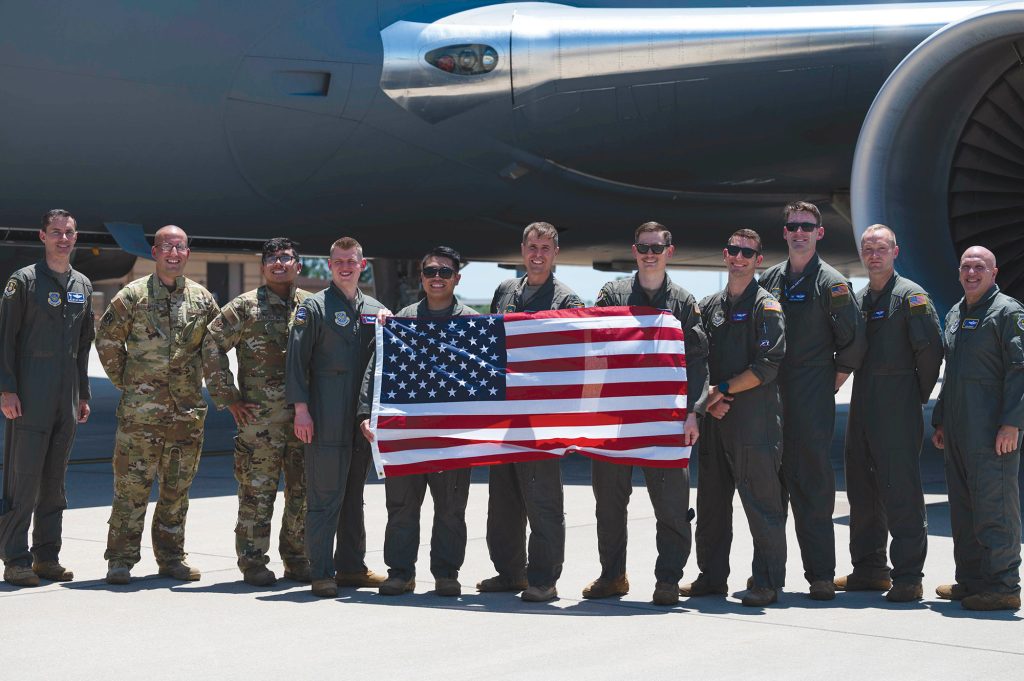A Journey of Time, Space, and Collaboration.
A KC-46 touched down at McConnell Air Force Base, Kan., on July 1 after a record 45-hour nonstop flight around the world. The mission, called Project Magellan, saw the two crews aboard test their limits as they refueled Air Force jets around the planet.
“Air refueling is a very specific process: you have to be at a point at a certain time,” Col. Brent Toth, aircraft commander and head of the 22nd Operations Group at McConnell, told Air & Space Forces Magazine. “And we did that four times all around the world without missing a beat.”
Project Magellan is the latest maximum endurance operation (MEO), the term for long-haul missions, meant to test Airmen as transport and tanker crews under Air Mobility Command prepare to carry the rest of the military’s troops and equipment across the vast distances of the Pacific in a possible conflict with China.
“In an era of great power competition, crews need the ability to operate longer than they have in the past, and Project Magellan is the next step in getting AMC crews experience in the game-changing new construct that is MEO,” said Capt. Cody Donahue, 22nd Operations Group executive officer, who took part in the flight and played a key role planning it, in a press release.
The idea for Project Magellan first came to tanker crews at McConnell about two years ago, but the team had to work fast over to get ready once the coordination with units around the world finally took shape.
“Once that came together, we had to move out very quickly,” Toth said. “The sprint for the last 30 days has been pretty hard, but we had a fantastic planning team.”
Commander 22nd Operations Group, Col. Brent TothThis just wasn’t about taking off and landing somewhere else. … We did complex missions in each part of the world.
At the end of the sprint was the mission itself, which broke new ground for the KC-46. In 2019, a McConnell crew first flew a Pegasus around the world, but that trip included six stops and overnight stays. Project Magellan marked the first time the new tanker flew around the globe nonstop.
Besides the length of the flight, the MEO also stood out for carrying just two basic crews. Normally, three Air Force pilots can fly as an augmented crew for up to 24 hours, but Air Mobility Command now wants crews of four pilots to fly up to 48 hours to prepare for future conflicts, Donahue explained.
When the KC-46 took off from McConnell at about 4 p.m. on June 29, it carried just four pilots, two refueling boom operators, two flying crew chiefs to oversee the health of the airplane, and a flight surgeon to oversee the health of the crew.
The next 45 hours saw Magellan take gas from another KC-46 off the coast of California; give gas to a C-17 transport jet training near Hawaii; and take on more gas from two other McConnell-based KC-46s as they approached Guam.
Over the Middle East, the thirsty Pegasus received more fuel from a pair of KC-135 tankers flying out of Al Udeid Air Base, Qatar, where one crew was from McConnell and the other was from the Utah Air National Guard. The Magellan crew went on to refuel two F-15E Strike Eagles flying a combat sortie over Iraq, then meet two KC-135s for more gas over England: one from McConnell and one from RAF Mildenhall. The McConnell tankers had been pre-positioned around the world to support the MEO.
The KC-46 enjoyed a hero’s welcome back over the continental U.S., where the jet met up with another McConnell-based KC-46 and the two refueled three B-2 stealth bombers from Whiteman Air Force Base, Mo., then offloaded fuel onto another McConnell Pegasus with Brig. Gen. Gerald Donohue, AMC’s director of operations for strategic deterrence and nuclear integration, onboard as an observer.
When they finally landed back at McConnell at around 1 p.m. on July 1, Magellan had taken on 454,000 pounds of gas—about the weight of two blue whales—over the course of four refuelings from seven different tankers, and contributed to a combat sortie and a training exercise.
“This wasn’t just taking off and landing someplace,” Toth said. “We did complex missions in each part of the world.”
Part of what enabled such a long string of midair meetings was a suite of systems allowing beyond-line-of-sight communications among the Magellan crew, planning teams at McConnell, and crews around the world. Tactical data networks such as Link 16 allowed them to track and communicate with receiving aircraft hundreds of miles away to find out what direction they were traveling, how much fuel they needed, and other factors which normally would not be communicable until the aircraft were much closer within radio contact.
“We knew more about what was happening on this flight than I’ve known on most of the flights that I’ve been part of throughout my career,” Toth said. “So even though it was more complex than anything I’ve ever done, I felt like I was more notified than I’ve ever been before.”
While Link 16 is already widely available in other parts of the Air Force such as Air Combat Command, Air Mobility Command is still getting up to speed in terms of connectivity. Last year, AMC boss Gen. Mike Minihan set a goal to connect 25 percent of the tanker and transport fleet with beyond-line-of-sight communications by 2025.
The relatively new KC-46 has more modern communication equipment compared to its older siblings in the mobility fleet such as the KC-135 and the C-130, but flying between four combatant commands and quickly syncing with each one on the same flight is an achievement in its own right, Toth and Donahue explained.
“We always talk about air refueling being a sort of force multiplier, well, same thing with this tactical data link,” Donahue said. “Now you are talking about two force multipliers on one platform, so you’re exponentially multiplying your force.”
Besides solid communications, Magellan also benefited from years of research in human performance. Flying an aircraft is a tiring task, and Air Mobility Command wants to use the latest science in sleep and nutrition to keep crews as well-rested as possible on long sorties.
At first, the two Magellan crews took 10-hour shifts, but over time those shrank to between six and seven hours. When not at work, crews slept on bunks in a rest area that was kept dark throughout the flight. Other Airmen have said the KC-46 is a more comfortable experience than past refueling tankers.
“I was able to get five or six hours of sleep multiple times with a sleep mask and noise-canceling headphones or earplugs,” Donahue said. “It’s really not too bad, and it allowed us to just keep this sustained operation with only four pilots flying 45 hours.”
To prepare for the flight, the first crew tried to go to bed at around 4 a.m. and sleep until noon about three days prior to takeoff, while the second crew went to bed at 4 in the afternoon and woke up at midnight.
“It was pretty amazing how quickly we were able to adjust to that new timeline,” Donahue said.
It also helped that one crew member made cookies using the galley onboard, and another, instructor pilot Capt. Daison Batangan, brought a birthday cake to celebrate turning 31 years old midflight. By the time they were back over the U.S., the crew members were feeling the effects of a very long day, but they still safely accomplished what Toth described as one of the most complex operations he’s seen near McConnell in a long time.
“Meeting up with another tanker for a midmission join-up and then doing formation aerial refueling against three B-2s, it was pretty fantastic,” he said.
“I’d fly 45 hours just to refuel B-2s any day of the week,” Donahue added.
When they landed back at McConnell, the crew had experienced just one sunrise and one sunset on their long westbound flight, “so even though it’s been 45 hours, we’ve really experienced only one solar day,” Toth said. “So that is a bit of a mind trip.”
Even more than a test, the colonel thinks Project Magellan demonstrated AMC’s ability to reach anywhere on Earth.
“Taking off from the [continental U.S.], refueling a C-17 over the Pacific and a combat sortie over Iraq, and coming back to support global strike aircraft showcases that we really can provide air refueling and support global reach anytime, anywhere,” he said.
The complete crew list included Col. Brent Toth, aircraft commander; Capt. Cody Donahue, instructor pilot; Capt. Daison Batangan, instructor pilot; Capt. T.J. Buckley, instructor plot; Master Sgt. Jonathan Lauterbach instructor, boom operator; Master Sgt. Patrick Murray, instructor boom operator; Capt. Jacob Heyrend, flight surgeon; Staff Sgt. Alejandro Melendez, flying crew chief; and Staff Sgt. Dustin Shaffer, flying crew chief.



